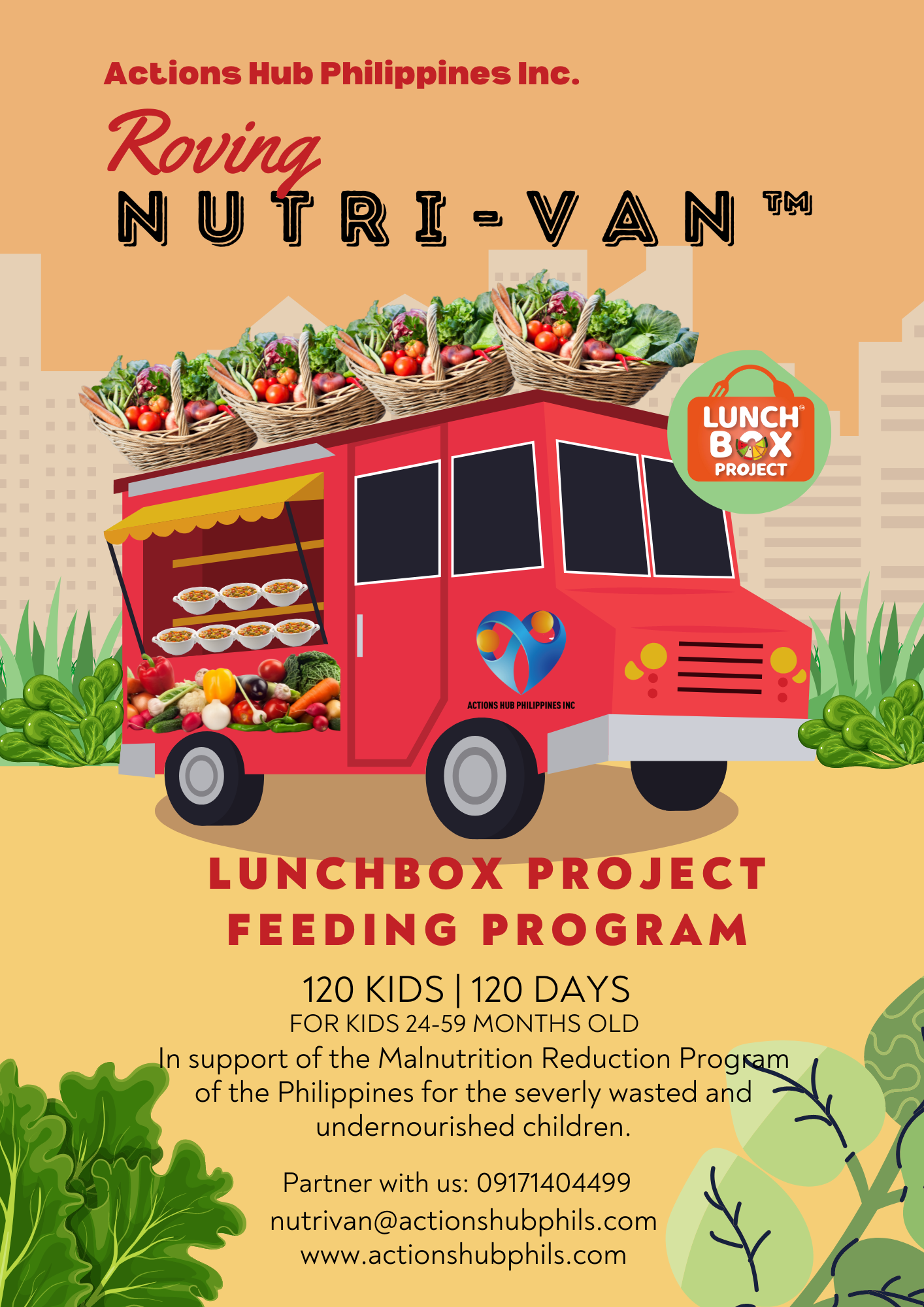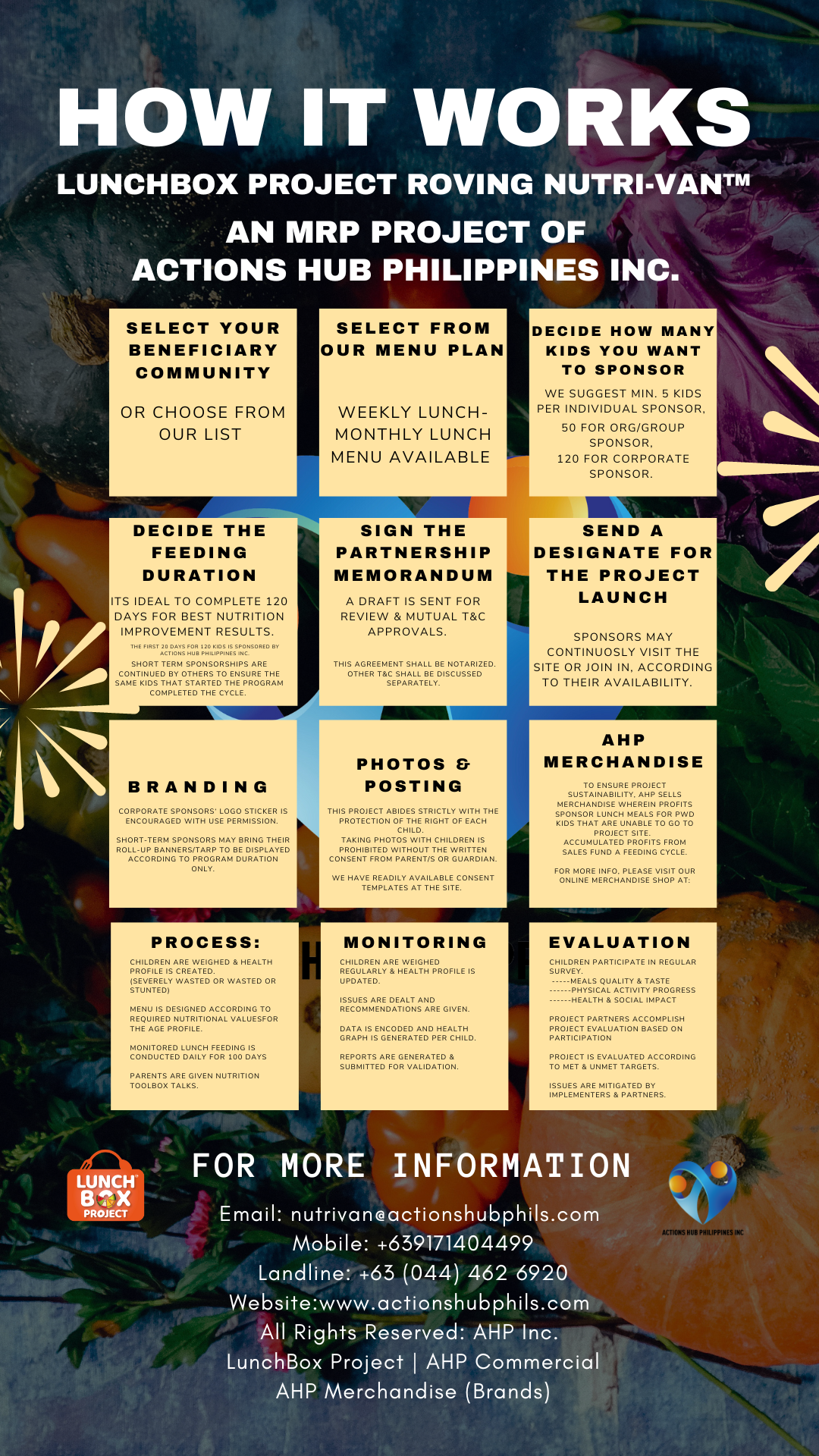Roving Nutri-Van™️
Roving Nutri-Van™️
120 kids | 120 days
Barangay to Barangay

According to The World Bank Report
The Philippines is ranked fifth among countries in the East Asia and Pacific region with the highest prevalence of stunting and is among the 10 countries globally with the highest number of stunted children. Based on the World Health Organization’s (WHO) classification of undernutrition rates, the stunting prevalence of children in the Philippines is of “very high” public health significance.
Undernutrition robs Filipino children of their chance for a bright future. According to the World Bank’s Human Capital Index (HCI)— a Filipino child born today is likely to reach only 52% of their future potential economic productivity as an adult, compared to a child with access to complete education and full health. Children growing up in poverty need equalizing investments in their nutrition, health, education, and wellness, in order to reach their full potential as healthy, skilled adults who are able to improve their quality of life.
The World Bank Policies and Programmatic Recommendations
- Adequate financing for nutrition.
- Build a strong and closely coordinated partnership for nutrition.
- Implement large-scale proven direct nutrition interventions.
- Address determinants of nutrition through multi-sectoral approaches.
- Establish geographic convergence of key sectors.
- Data collection, monitoring, and evaluation.
Our Response
As a non-government community based organization, Actions Hub Philippines, Inc. under its LunchBox Project Division conceptualized the Roving Nutri-Van™️ in our aim to contribute to the reduction of malnutrition prevalences in our country.
Roving Nutri-Van™️ Project aims to bridge some gaps we identified reference to our many experiences in implementing feeding programs. We envision that the objectives we incorporated in this project ensure program success with validated quantifiable results:
- Implement monitored feeding -actual feeding, not just distributed food packs.
- Represent the partners & collaborators -our team will be the personnel at site on behalf of the collaborators with limited time & resources.
- Packaged the program -this project can be done simultaneously in different areas, using the same project manual & procedures.
- Project Junction -we designed the project junction in order that the short-term donors & partners collaboratively finish a feeding cycle, one after another.
- Localized the procurement -the nutritious food packs that will be served in this project are produced and manufactured by the community of livelihood, cooperatives, government funded MSMEs, local farmers & local producers.
- Standardized Menu -for 120 days, we have based our menu on the standard nutritional guidelines of DOST-Food and Nutrition Research Institute as well as from the products that are developed by DOST-FNRI which are defused to technology adapters.
How it Works:
The List:
Since our activities are mostly collaborated with the Department of Science and Technology (DOST) and we also supplied their nutritious foods requirements for the Community Enhancement Through Science & Technology (CEST) Feeding Program, we were able to expand our beneficiaries when we decided to include their list in ours.
We also want to give back to Department of Education (DEPED) for their patronage of our nutritious food products. It is our voluntary initiative to include the DepEd SBFP beneficiaries to our list.
Currently, under DOST CEST we have identified, verified & coordinated lists from Regions III, MIMAROPA and Bukidnon in Region X and soon Bicol Region as it was listed to have the highest number of malnourished children.
For the DepEd SBFP list, we have beneficiaries from the provinces & cities of Bulacan, Pampanga, Tarlac, Cavite, Rizal, Muntinlupa, Laguna, Tacloban, Samar, Northern & Eastern Samar, Camarines Sur & Masbate.
Our Menu:
We have designed the nutritious foods menu utilizing the nutritious products that are produced and manufactured by our community partners which are all certified DOST/FNRI adaptors like Enhanced Nutribuns, Nutripacks, NutriCookies, NutriBars, NutriDrinks and NutriSnacks that are all proven effective to improve child's health with balanced nutrition content sufficient for a child's requirement to survive a day's hunger.
Sponsorships:
As specified by the Department of Education, a malnourished (stunted & severely wasted) child must be given proper feeding program within 100 to 120 days in order to see the progress in his/her nourishment.
We have designed this campaign for 120 days, wherein the first 20 days is a donation of Actions Hub Philippines under LunchBox Project and the succeeding 100 days are donated by the collaborators or partners.
The invitation to collaborators is an open decision to choose the number of kids and the number of days they want to sponsor. We recommend or suggest a minimum of 5 kids per individual sponsor, 50 kids for group or organization sponsors and 100 for corporate sponsors. This way we can immediately accumulate these numbers to complete the cycle of 120 per batch.
Feeding Duration:
As mentioned above, our goal is 120 days. 20 care of AHP LBPS and 100 care of sponsors.
However, we also considered sponsorships that specify limited number of days. The short-term donations are to be continued by the next sponsor in order for the same beneficiary to complete the feeding cycle.
Memorandum of Agreement:
Each sponsor will be given the MoA which contains the following:
- Obligations of Parties
- Dashboard (for full 120 days, 120 kids)
- Restrictions (including social media postings)
- Amount of Sponsorship
- Menu
- List of beneficiaries and their nutrition profiles
- Coverage of Sponsorship
- Branding
- Schedule of visits & activities
- Monitoring
- Evaluations
- Documentations
Monitoring:
Each beneficiary will have his/her own health profile from entering the program, during the program and after the program. The profile is limited to weight & height versus age upon entry and progressive data related to the focal areas as specified by DOH and UNICEF of a child's normal required nourishment.
Evaluation:
The program is evaluated every cycle. The evaluations are based on the key performance indicators listed in the project document.
These data are compared from projection versus actual in order to analyze the efficacy of the program as well as the validation of the nutritional components of the given food products.
Reports Generation:
All reports after validation by experts are to be submitted to the DOH for inclusion in the progress report by partners and stakeholders who joined or participated in the Multi-Sectoral Nutrition Plan and the National Malnutrition Reduction Program.
